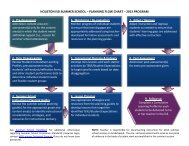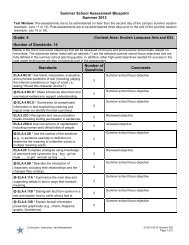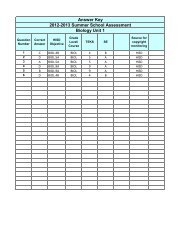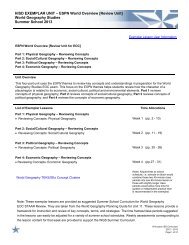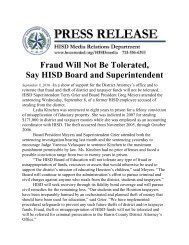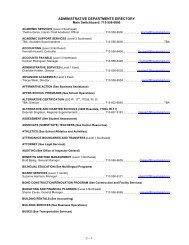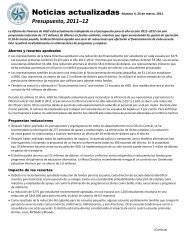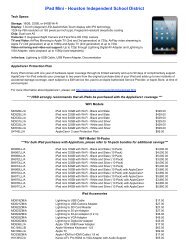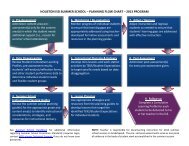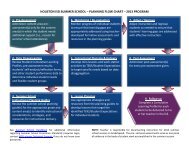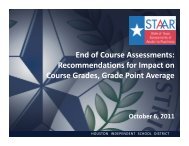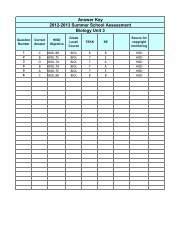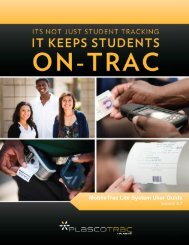SSK Unit 4.2 Planning Guide
SSK Unit 4.2 Planning Guide
SSK Unit 4.2 Planning Guide
Create successful ePaper yourself
Turn your PDF publications into a flip-book with our unique Google optimized e-Paper software.
Instructional ConsiderationsManager Grade 8, <strong>Unit</strong> 9 in Resources. (ELA.8.11B)HISD PLANNING GUIDEEnglish Language Arts Grade 8SUMMER SCHOOLFormative Assessment- Divide students into two groups and announce that students will debate the topic: Should P.E.Be Required? Assign one group to be for and one to be against. Give groups time to construct and make note of theirarguments. When time is up, have both groups present. Then, have groups discuss the similarities and differences intheir arguments. See Formative Assessment- Should P.E. Be Required?Formative Assessment- To ascertain if students are able to independently compare and contrast two persuasivepieces and analyze the use of rhetorical strategies, have students complete the following assessment. Students aregiven two pieces that take both side of an issue and then answer multiple choice questions. See FormativeAssessment- Vending Machines- Yea or Nay? in Assessment Connections.Instructional Accommodations for Diverse Learners ELLs may need support during shared reading or when retelling or summarizing what they have read.Use the following sentence stems to support ELLS:• Can you help me understand…?• Would you please repeat that?• It’s about…• The main idea is…See Navigating the ELPS in the English Language Arts and Reading Classroom in Resources.(ELPS C.2g)Provide students with sentence starters to help scaffold inferences and commentary. Sentence starters can include: The speech appeals to _____________ because ___________. The author’s use of _____________ creates a sense of ___________. By stating _________, the author ______________. The word __________ suggests ______________. The image __________ suggests _____________.Instructional Accommodations for Diverse Learners This type of scaffolding is essential to building the academic success of ELLs. Post these and othersentence starters in the classroom and remind ELLs to start with these when they are making inferences.As students become more independent in analyzing how an author influences an audience, encourage the use ofDialectical Journals. Dialectical Journals offer students a means to develop their thinking about the rhetorical devicesand appeals and create commentary and interpretation. Reiterate to students that it is not enough to identify a particularrhetorical device. Students must be able to evaluate the effects of the devices. For more information on DialecticalJournals, see ELA Best Practices MS in Resources. See “I Have a Metaphor” in Resources.Dialectical Journals may be too difficult for some students. Have struggling students begin with a simpler graphicorganizer to develop their evaluation skills. Instead of having students identify the rhetorical devices being used, providea chart with the devices already listed. See Evaluation Chart in Resources.Instructional Accommodations for Diverse Learners For ELLs who are struggling with analysis, use an accommodation that limits the analysis to somebasic characteristics. See Speech Analysis Chart in Resources.Explain that authors of persuasive texts use rhetorical devices, tone, and perspective to influence an audience. Reviewtone and author’s perspective and give examples from model texts. Provide opportunities for students to work in groupsto analyze perspective. See Understanding Author’s Perspective in Instructional Strategies.Instructional Accommodations for Diverse Learners To allow ELLs the opportunity to ask and give information, allow them to use Interview Grids. InterviewGrids help students record other student’s responses to various questions. Students wander around the - English Language Proficiency Standards (ELPS) - Literacy Leads the Way Best Practices - Aligned to Upcoming State Readiness Standard- State Process Standard R - State Readiness Standard S - State Supporting Standard© Houston ISD Curriculum2013 – 2014Page 4 of 11




